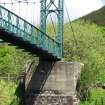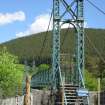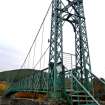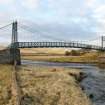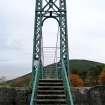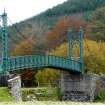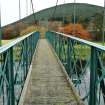Notice
Following a review of the Buildings at Risk Register we have paused the Register while we consider options for its future.
The website will remain accessible and searchable during this time, but it will not be updated and we’re not accepting nominations for additions to the Register. If you need to contact us about the BARR please email hmenquiries@hes.scot
Read the review report here and you can find out more about why we have paused the BARR on our news centre.
Elvanfoot Suspension Bridge, Elvanfoot
Ordnance Survey licence number AC0000807262. All rights reserved. © Copyright and database right 2025. Public Sector Viewing Terms
Useful Links
- Canmore:
- ELVANFOOT, SUSPENSION BRIDGE
- Historic Scotland:
- HS Reference No 6372
General Details and Location
Category
AT RISK
Name of Building
Elvanfoot Suspension Bridge
Other Name(s)
Address
Elvanfoot
Locality
Postcode
Planning Authority
Divisional Area
Reference No
3683
Listing Category
B
OS Grid Ref
NS 95399 17601
Location Type
Rural
HS Reference No
6372
Description
Pedestrian suspension bridge of ambitious span. (approx 125ft/38.5m) over River Clyde, a circa 1900 replacement of the 17th century masonry bridge destroyed by flooding in 1890s. (This route is the ancient, pre-Telford, north-south road).
Lattice truss span supported from lattice girder pylons, with wire-rope cables and stell rod suspenders. Steelwork bears letteirng "Lanarkshire Streel Co Ltd", and "Rowell/London" at cable tensioning points. Timber decking. Abutments are those of pre-existing bridge (bearing evidence of repairs carried out over the years), of rubble and ashlar; concrete facing and bedding co-eval with existing bridge.
Fragments of early parapets, ashlar-coped and unequally skewed on plan, survive on west bank; coping over north parapet is possibly original (ie 17th century); 19th century coping over south parapet. Approach on east bank is wider, and heightened close to level of parapet coping. On each bank, steel steps leading up to bridge deck. (Historic Environment Scotland)
Elvanfoot Bridge designed by Rowell & Co, was constructed in the 1920s to replace an earlier masonry bridge. This category B listed structure is the highest crossing point on the course of the River Clyde.(SBPT)
Lattice truss span supported from lattice girder pylons, with wire-rope cables and stell rod suspenders. Steelwork bears letteirng "Lanarkshire Streel Co Ltd", and "Rowell/London" at cable tensioning points. Timber decking. Abutments are those of pre-existing bridge (bearing evidence of repairs carried out over the years), of rubble and ashlar; concrete facing and bedding co-eval with existing bridge.
Fragments of early parapets, ashlar-coped and unequally skewed on plan, survive on west bank; coping over north parapet is possibly original (ie 17th century); 19th century coping over south parapet. Approach on east bank is wider, and heightened close to level of parapet coping. On each bank, steel steps leading up to bridge deck. (Historic Environment Scotland)
Elvanfoot Bridge designed by Rowell & Co, was constructed in the 1920s to replace an earlier masonry bridge. This category B listed structure is the highest crossing point on the course of the River Clyde.(SBPT)
Building Dates
1920s
Architects
Unknown
Category of Risk and Development History
Condition
Poor
Category of Risk
High
Exemptions to State of Risk
Field Visits
29/10/2008, 11/02/2010, 4/6/2013
Development History
October 2008: External inspection finds the bridge has been closed by the Local Authority due to safety concerns; the timber decking appears to be rotten and the wire rope cables appear corroded.
November 2008: Local planners report that whilst the Council has reponsibility for the bridge, ownership of the structure remains uncertain. A structural survey to assess repair costs has been undertaken by the Council. Offers of purchase and/ or repair of the structure would be considered by the Local Authority.
February 2010: Inspection finds this fine structure suffering from some corrosion to the supprt cables and from rot in the timber deck.
February 2012: A member of the public advises a demolition application is currently being for the bridge. Listed Building Consent for demolition and clearance of the bridge has been lodged, ref: CL/12/0068.
25 April 2012: Listed Building Consent for demolition of the bridge was withdrawn 20 March 2012.
14 September 2012: Strathclyde Building Preservation Trust is working with the local community to bring together a funding package for the repair of the structure. A detailed study is anticipated to be underway late 2012/ early 2013.
4 June 2013: Inspection finds no significant change from the previous site visit. SBPT worked with Elvanfoot Residents Association to prepare a Feasibility Study looking at the viability of repairing and reusing the B listed suspension bridge over the River Clyde, assisted by David Narro Associates, Charles Darley Associates & McGowan Miller. The project was funded by the South Lanarkshire Rural Community Heritage Fund and the Clyde Windfarm Community Fund. The study concluded that the bridge was particularly significant because of its location on an ancient and continuously used crossing over the River Clyde. Repair of the structure was found to be possible, although it is likey that this would involve dismantling the bridge and removing it for off site repair and conservation. SBPT continue to work with the local community to build a fundable project around the conservation of the bridge.
20 June 2021: A member of the public contacts the Register to advise one of the cables connecting the east pylon to the ground has snapped.
Guides to Development
Conservation Area
Planning Authority Contact
PAC Telephone Number
07551839698
Availability
Current Availability
Unknown
Appointed Agents
Price
Occupancy
Vacant
Occupancy Type
N/A
Present/Former Uses
Name of Owners
Unverified see FAQ on ascertaining ownership
Type of Ownership
Unknown
Information Services
Additional Contacts/Information Source
Strathclyde Building Preservation Trust: http://www.sbpt.org.uk/current-projects/elvanfoot-bridge.html
Bibliography
Online Resources
Classification
Roads and Paths
Original Entry Date
04-NOV-08
Date of Last Edit
21/06/2021



